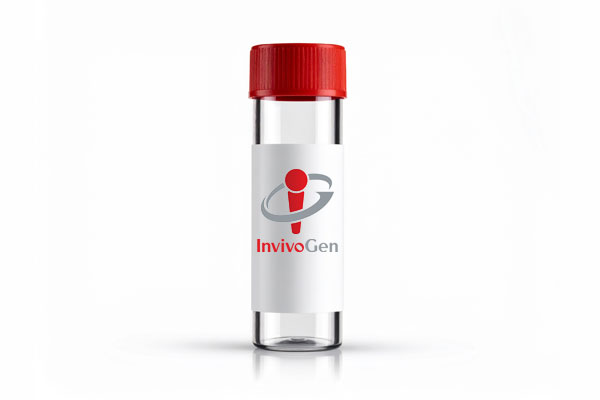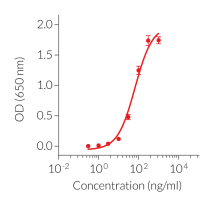ISD Naked
-
Cat.code:
tlrl-isdn
- Documents
ABOUT
CDS Ligand
ISD (interferon stimulatory DNA) is a 45 bp non-CpG oligomer containing bacterial DNA motifs. ISD derives from the Listeria monocytogenes genome. L. monocytogenes, the bacterium responsible for listeriosis, is a Gram-positive, facultative intracellular pathogen. This bacterium proliferates rapidly in the host cell cytosol while largely evading the induction of host cell death.
ISD/ LyoVec™ is a formulation of ISD complexed with the cationic lipid transfection reagent LyoVec™ to facilitate its cellular uptake.
Mode of action:
Intracellular DNA from pathogens is recognized by multiple cytosolic DNA sensors (CDSs), which display contextual preferences for the recognition of DNA [1]. When transfected into various cell types, including plasmacytoid and conventional DCs, macrophages, and murine embryonic fibroblasts, ISD strongly enhances the expression of IFN-β [1]. This ISD-induced response is mediated by the STING-TBK1-IRF3 signaling axis [1-2].
Key features of ISD:
- Potent inducer of type I IFNs
- Available naked or complexed with the cationic lipid LyoVec™
- Each lot is functionally validated
InvivoGen also provides ISD Control, a single-stranded oligonucleotide that does not induce type I IFNs, unlike its double-stranded counterpart.
![]() Read our review on cytosolic DNA sensors
Read our review on cytosolic DNA sensors
References:
1. Stetson D.B. & Medzhitov R. 2006. Recognition of cytosolic DNA activates an IRF3-dependent innate immune response. Immunity. 24(1):93-103.
2. Ishikawa H. et al., 2009. STING regulates intracellular DNA-mediated, type I interferon-dependent innate immunity. Nature. 461(7265):788-92.
All products are for research use only, and not for human or veterinary use.
SPECIFICATIONS
Specifications
Cytosolic DNA sensors (CDSs)
5’-TACAGATCTACTAGTGATCTATGACTGATCTGTACATGATCTACA-3’
3’-ATGTCTAGATGATCACTAGATACTGACTAGACATGTACTAGATGT-5’
- 100 ng - 10 μg/ml transfected ISD naked
- 300 ng - 10 μg/ml ISD/LyoVec™
Naked
Negative (tested using EndotoxDetect™ assay)
Cellular assays
Each lot is functionally tested and validated using THP1-Blue™ ISG Cells.
Control: ISD Control single-stranded oligonucleotide
CONTENTS
Contents
-
Product:ISD Naked
-
Cat code:tlrl-isdn
-
Quantity:200 µg
1.5 ml of sterile endotoxin-free water
Shipping & Storage
- Shipping method: Room temperature
- Upon receipt, store at -20°C.
- Avoid repeated freeze-thaw cycles
Storage:
Caution:
Details
STING (stimulator of interferon genes) has become a focal point in immunology research and drug discovery [1, 2]. In a healthy individual, STING functions as a signaling hub, orchestrating immune responses to pathogenic, tumoral, or self-DNA detected in the cytoplasm [2]. Upon activation, STING induces type I interferon (IFN) production through TANK-binding-kinase-I (TBK1)-mediated IFN regulatory factor (IRF3) signaling [2]. STING activation also leads to NF‑κB-dependent inflammatory cytokine production [2]. In some autoimmune diseases such as STING-associated vasculopathy with onset in infancy (SAVI), STING is constitutively activated resulting in high IFN production [3, 4]. The discovery of a mechanism to pharmacologically inhibit STING should lead to new treatments for such diseases.
Reference:
1. Haag S.M. et al., 2018. Targeting STING with covalent small-molecule inhibitors. Nature 559:269-73.
2. Ishikawa H. & Barber G.N. 2008. STING is an endoplasmic reticulum adaptor that facilitates innate immune signalling. Nature 455:674-8.
3. Liu Y. et al., 2014. Activated STING in a vascular and pulmonary syndrome. N Engl J Med. 371:507-18.
4. Jeremiah N. et al., 2013. Inherited STING-activating mutation underlies a familial inflammatory syndrome with lupus-like manifestations. J Clin Invest. 124:5516-20.
DOCUMENTS
Documents
Technical Data Sheet
Safety Data Sheet
Certificate of analysis
Need a CoA ?




